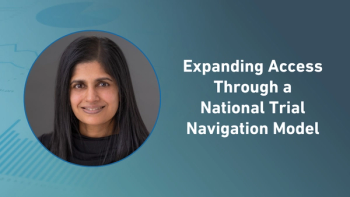
Advancing Inclusive Recruitment in Trials
In this video interview, Ramita Tandon, chief biopharma officer at Walgreens, shares how the company is driving more inclusive enrollment by engaging diverse communities, developing culturally competent materials, and meeting patients where they are.
In a recent video interview with Applied Clinical Trials, Ramita Tandon, chief biopharma officer, Walgreens, discussed the company’s three-year milestone of leading clinical trials. Tandon highlighted several of Walgreens’ initiatives in the space, including how its 8,000+ pharmacy locations are bringing research directly into communities. She emphasized the need for community-based partnerships, cultural competence, and education to empower patients. Looking forward, strategic partnerships will be key in enhancing inclusivity and accessibility, with the ultimate goal of bridging gaps in clinical research and public health.
ACT: Walgreens’ patient population is 44% racially or ethnically diverse. What practical steps can clin ops teams at sponsors or CROs take to replicate that kind of inclusivity in recruitment?
Tandon: This is such a critical part of, I think, ensuring that we can bring clinical trials into all communities, because I think historically and to some extent today, we've been reaching out to the same set of patient populations, which has led to the earlier statistic that I made, about less than 5% of patient populations participating in clinical research, and I think one of the key things is, is that we have to acknowledge that in order for us to engage in communities, it is has to be a bidirectional approach, which means we've got to spend the time to educate and empower patients to feel comfortable and understand, number one, what a clinical trial is, making sure they're being invited, and those conversations then become imperative in how they can start to make decisions and feel empowered to make that decision, to want to participate. That is not something that needs to be happening after the fact, but rather it needs to be in the DNA of how we conduct the future of clinical trials. Along those lines, it's about making sure that once we've done those education and empowering, when we engage the patients, it's making sure that we're creating culturally competent materials, materials that reflect who the communities are, materials that will actually invoke response and to be able to get patients to be able to say, “Yes, I trust what I'm seeing. I trust what I'm hearing. I feel comfortable to want to participate,” and this is why we're leveraging our Walgreens infrastructure, our assets, our trust, in a way to be able to get patients to engage and participate. Obviously, Walgreens has been in many of the communities we service, many of the underserved communities, so there's already a knowledge of how to be able to engage those communities, because they're coming in to pick up their prescriptions, they're talking to their pharmacists and the care teams that are at the at the stores and pharmacies. We're using a lot of that insights and knowledge to help us and make sure that that patients can be enrolling into clinical trials. I would say, in general, you've got to be intentional. You've got to be purposeful and create an ecosystem of community-based partnerships. So at Walgreens, when we host a number of events before clinical trials are launched, many of these events are taking place at our stores and pharmacies, but they're also in partnership with many of our local community partners that come along with us and start to create that surround sound and creating more of an ecosystem that allows patients to get comfortable. For us at Walgreens, we call it the Triple-E Framework. We engage, we empower, and we enable, and that allows us to drive action for bringing patients from all communities to participate.
Newsletter
Stay current in clinical research with Applied Clinical Trials, providing expert insights, regulatory updates, and practical strategies for successful clinical trial design and execution.




